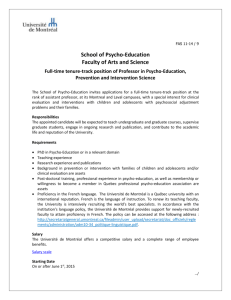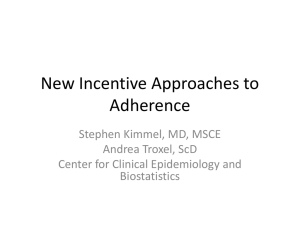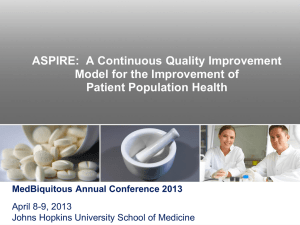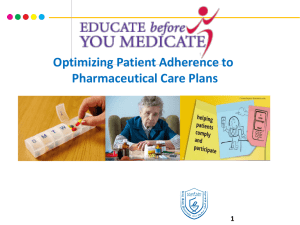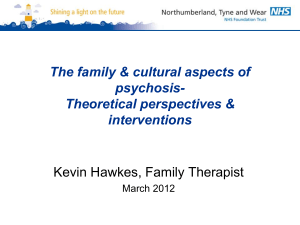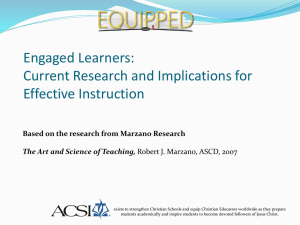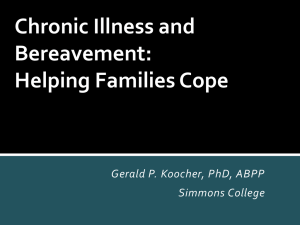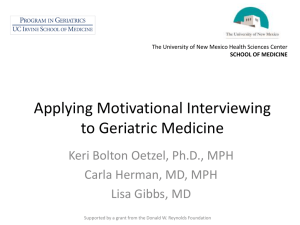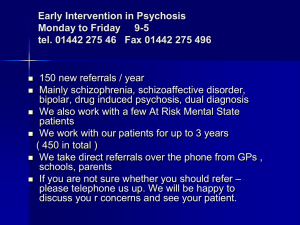healthcare expenditures - South East and Central Essex Mind
advertisement
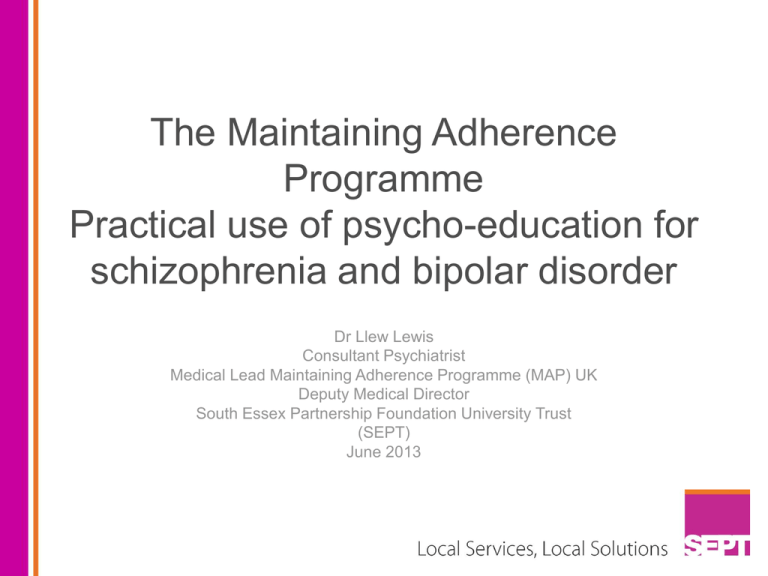
The Maintaining Adherence Programme Practical use of psycho-education for schizophrenia and bipolar disorder Dr Llew Lewis Consultant Psychiatrist Medical Lead Maintaining Adherence Programme (MAP) UK Deputy Medical Director South Essex Partnership Foundation University Trust (SEPT) June 2013 Overview 1. Our organisations-partnership between SEPT and Janssen 2. The Munich Compliance Programme 3. Developing our model: The Maintaining Adherence Programme (MAP) 4. Practical tips for psycho-education based on our experience in the MAP 5. Interim results South Essex Partnership University Foundation Trust • Integrated care including mental health, learning disability, social care, forensic and community health services • 200 locations across Bedfordshire, Essex, Luton and Suffolk • Employ approximately 7,000 people • Serve a population of 2.5 million • Annual turnover of approximately £350m The “Munich Compliance Program” • Dr Werner Kissling and colleagues, Munich: • Recognised significant relapse rates in the year post discharge from hospital • Non-adherence to treatment a factor • Developed a model to address nonadherence: Munich Compliance Program developed to address low adherence and high readmission rates The impact of schizophrenia on healthcare budgets is substantial, typically between 1.5 and 3% of total national healthcare expenditures. THE SOLUTION THE PROBLEMS One year readmission rates = 45% >50% of patients are non-compliant Clinical studies have demonstrated that psycho-education and wellness programmes significantly increase patient compliance and outcomes* Benefits of Psycho-education Compliance programmes are lacking Annual costs of 5 billion Euros in Germany Frustrated patients, payers, carers and healthcare providers Therapeutic alliance Patient knowledge of disease Self-management of symptoms Symptom severity Adherence to medication Risk of relapse/ hospitalization Functional outcomes *Rummel-Kluge & Kissling. Curr Opin Psychiatry 2008; 21: 168–172 *Mueser et al. Psychiatr Serv 2002;53:1272–1284; Mueser & McGurk. Lancet 2004; 363: 2063–2072 Munich Compliance Program 1. “Differential diagnosis” of non-adherencea standardised approach to assessment of risk factors (at baseline and 3 monthly): • Insight • Drugs/alcohol • Side effects • Beliefs and attitudes to treatment • Cognitive factors, carer support… Cont. 2. Psycho-education for all patients and relatives: • group setting, two facilitators • 11-12 modules, manualised approach • 1-2 hours per week • Topics: symptoms, diagnosis, treatments, early warning signs of relapse, crisis planning, drugs/alcohol, relationships, recovery Cont.. 3. Peer-to-peer psycho-education 4. Family-to-family psycho-education 5. Shared Decision Making: • High quality information • Collaborative partnership approach Cont.. 7. Incentives for patients: • Financial • Pleasant lounge atmosphere for groups • Good coffee 8. Reminder systems 9. Home treatment 10.Wellness Elements: • “Nordic Walking”, ”Coffee and Culture” 11.Depot clinic 12.Evaluation 13.Publication The Joint Working Agreement & funding arrangements The “Maintaining Adherence Programme” Objectives of the Project • To partner with Janssen under a Joint Working agreement*: • To translate and modify an Adherence model originally developed in Munich to a UK contextworking with Dr. Werner Kissling • To test the model within SEPT, an innovative mental health Trust in the south east of England. • To produce an evaluation of the clinical and economic benefits and outcomes *Department of Health Joint working guidelines : http://www.dh.gov.uk/en/Publicationsandstatistics/Publications/PublicationsPolicyAndGuidance/DH_082370 Why is this approach being considered? • Despite advances in psychopharmacology and service innovations(UK National Service Framework 1999), patients still relapse, • Therefore, the aim is to: • Improve the quality of care and outcomes for people with diagnoses of schizophrenia, schizoaffective and bi-polar disorders through a focus on relapse prevention • Improve productivity: reduce overall resource usage in a climate of radical financial pressures Who is the MAP team? • Consultant Psychiatrist (0,4 WTE) • 3 WTE nursing staff (inc. 1 WTE team leader) • 2 0,5 WTE occupational therapists Supported by: • Project management: SEPT/Janssen) • IT support (ipad data collection/synching with Trust data systems) What interventions does the UK model provide? • “Differential Diagnosis of non-adherence” o initial and 3 monthly formal review of risks associated with poor adherence • Psycho-education for service users: o Schizophrenia & Schizoaffective Disorder + Bi Polar Disorder • Psycho-education for families & care givers o Peer to peer Psycho-education • Reminder Service (telephone/text) • Shared Decision making approach • Wellness Activities A.Establishing the team 1. Identify the team • Experience in working with schizophrenia and bipolar disorder • Not necessarily group facilitation nor education skills 2. Familiarise with content of modules 3. Challenge clinician beliefs and assumptions • “Patients wont understand the content” • “I don’t understand the scientific/psychological models” • “I have never facilitated a group” cont… 4. Role play: – – – – – Being the facilitator Learning how to facilitate in pairs Being a member of a group Enacting different scenarios or answering questions Getting used to using flip chart, writing on white board, operating the iPad 5. Operational structure • Guidelines, paperwork, ipad data syching B. Identifying the patients 5. Raising awareness: • Designing flyers • Road-shows on wards, at CMHTs • Developing referral criteria: an admission to a ward, episode under CRHTT in the past 3 years 6. Recruiting and consenting patients 7. Designing and equipping a “Recovery Lounge” C. Creating a process 8. Creating a process: a) Streaming b) Setting up c) Settling in d) Structuring e) Summation f) Skills a) Streaming • Be aware of differing chronicity of illness and functional/ cognitive abilities • The presence of positive or negative symptoms • Whether symptoms are controlled or not • Differing social skills • Use wellbeing activities or baseline assessments to form an opinion (MOCA) Negative symptoms/ lower Global Assessment Functioning (GAF) • • • • • • Smaller groups (up to 5) Slower pace, more didactic, more repetition Adapt video clips..often shorter More active facilitation, Encouragement and positive feedback Take time to tease out symptoms and help participant relate content to experience Cont... • May need to revisit content in one to ones • E.g. Early warning signs identification and crisis planning... • Be sensitive to educational attainment • Participants may lack basic reading and writing skills • May be ashamed, may not admit to deficits in a group...check this out beforehand Higher functioning/social skills • • • • Up to 8 manageable Often more engaged Ask challenging questions More likely to read materials and do inter-group tasks • As group matures, the group facilitation becomes delegated: empathic, supportive and encouraging of one another b) Setting up • • • • • • • Soft incentives add value The "Recovery Lounge" Comfortable chairs, couches, temperature Refreshments, coffee, tea, water Toilet access iPad and TV connected Name labels Cont.. • • • • Participant and facilitator manuals Pens and paper Group "rules" and "expectations" displayed Other resources: leaflets for support groups, patient medication info leaflets, Flip charts and whiteboards • • • • Agenda and group structure Open questions referencing manual content Prompts for video and activities Whiteboard for recording group answers and using "own words" • Ordering spontaneous responses into clear domains e.g. side effect types or classes of antipsychotics Prepare for surprises • Ideally two facilitators • If required one may have to leave the group with a participant if distressed to handover to another team member to contain • Aim not to stop the group • Managing distress well sends message facilitators can contain difficult scenarios- the group is safe c) Settling in • Report to reception • Customer care approach: our values Positive hellos/goodbyes, common courtesies, keeping promises, active listening • • • • Offer refreshments Make introductions Remind each other of names Facilitators support informal social interactions d) Structuring/timing 1. "Welcome..how are you?" a. Needs to be time limited( especially in Bipolar groups) 2. 3. 4. 5. Recap:"what did we learn last week?" "Any questions" Make time to review any homework Introduce new topic: aim to use open questions to gauge knowledge of the group For example: • What medications do you know? – Use whiteboard to capture responses • Facilitate as much from the group as possible. • Arrange information into understandable groups like: – Antipsychotics, antidepressants, side effect medication • Group quite possibly has experience of many different types Continued... • • • • Get the group to do the work Fill in the gaps at the end Encourage participation Acknowledge the lived experience and knowledge of the group • Move away from didactic stance to collaborative participation Continued ... 6. Review, recap and summarize a) Consolidate using participant language if possible 7. Questions and answers 8. Hand out materials…homework 9. Feedback: "How do you think the group went?" "Did we pitch it at the right level?" "What could we do better?" e)Summation • Process notes • Signposting as required: – – – – To consultant clinic To review or booster sessions Shared decision making session One to one work on relapse signatures/ crisis planning – "Choice and medication“ website • www.choiceandmedication.org f) Skills • • • • • Communication Verbal and non verbal Group facilitation techniques Educative techniques Clinical skills: listening, empathising, limited disclosing • Customer service : values into action Beyond the group.. • Operational staff: Wellbeing activities Three monthly adherence review • Medical: Shared decision making Urgent assessments and reviews …principles… • Reminding… linking back to group content to answer questions about: The need for medication How medication works Dopamine and psychosis Types of medications/comparisons Identifying early warning signs Crisis plans How will we evaluate the MAP program? Retrospective evaluation to include: Resource use Prospective evaluation to include: Resource use Clinical measures Patient satisfaction Staff satisfaction Recruitment summary Demographics Total number of MAP attendances (clients at 12 months post MAP entry) Nature of MAP contacts (clients at 12 months post MAP entry) MARS score (medication adherence rating scale) - baseline Vs most recent Risk score (baseline Vs most recent) Resource use in 12 months pre and 12 months post MAP entry Client and carer MAP experience questionnaires Which parts of the program did you find most helpful? How well has the psychoeducation programme helped your understanding of the following......? Psychoeducation evaluation forms Staff feedback • Staff interview participants were overwhelmingly positive about the MAP Program, describing many benefits from it for both patients and staff. Where potential improvements were identified, these related mainly to support for the service; for administrative tasks and for appropriate referral of patients into and onward from the Program, and not to changes needed in the Program itself. However there was great willingness to learn from continuing feedback from patients and carers, to improve the Program if necessary. Summary • MAP interventions in addition to usual care plan • Psycho-education, reminder service, wellbeing components, SDM, rapid access to consultant if required • 12 month Qualitative and economic evaluation promising • Awaiting final evaluation Thank you
